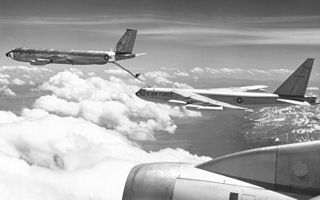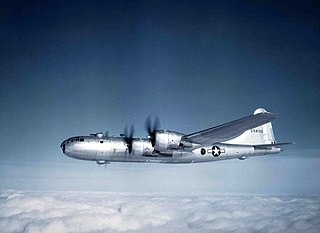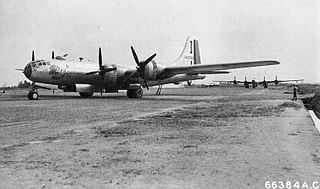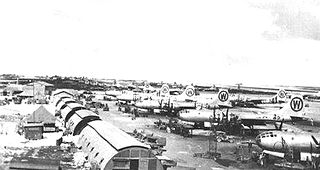
The XX Bomber Command was a United States Army Air Forces bomber formation. Its last assignment was with Twentieth Air Force, based on Okinawa. It was inactivated on 16 July 1945.

The 58th Air Division is an inactive United States Air Force unit. Its last assignment was with Air Defense Command, based at Wright Patterson Air Force Base, Ohio. It was inactivated on 1 February 1959.

The 444th Air Expeditionary Wing is a provisional unit of the United States Air Force assigned to Air Combat Command to activate or inactivate as needed. It was last activated in 2003.

The 462d Air Expeditionary Group is a provisional unit of the United States Air Force. It is assigned to Air Mobility Command to activate or inactivate as needed to meet operational requirements. Its last assignment was at Naval Support Facility Diego Garcia, British Indian Ocean Territory.

The 504th Bombardment Group was a World War II United States Army Air Forces combat organization.

The 346th Bombardment Group is a former United States Army Air Forces unit. It was last assigned to the 316th Bombardment Wing at Kadena Airfield, Okinawa, where it was inactivated on 30 June 1946. The group was originally a heavy bomber training unit, but was inactivated in a general reorganization of Army Air Forces training units in 1944. It was reorganized as a Boeing B-29 Superfortress group later that year. It moved to Okinawa in 1945, but arrived too late to participate in combat.

The 6th Attack Squadron is an active United States Air Force unit, assigned to the 49th Wing at Holloman Air Force Base, New Mexico. The squadron is a formal training unit for crews learning to operate unmanned aerial vehicles.

The 435th Bombardment Squadron, also known as the "Kangaroo" Squadron, is an inactive United States Air Force unit. It was formed in Australia in March 1942 as the 40th Reconnaissance Squadron and participated in combat in the Southwest Pacific Theater until November, when it was withdrawn from combat and returned to the United States, where it acted as a Replacement Training Unit until October 1943, when its personnel and equipment were withdrawn.

The 45th Bombardment Squadron is an inactive United States Air Force unit. Its last assignment was with the 40th Bombardment Wing, based at Forbes Air Force Base, Kansas. It was inactivated on 1 September 1964.

Dudhkundi Airfield is an abandoned airfield in India, located 12 miles (19.2 km) SE of Jhargram, in the Jhargram district in the Indian state of West Bengal.

Piardoba Airfield is an abandoned airfield in India, located 6.6 miles (10.7 km) S of Bishnupur, West Bengal, Bankura District in the state of West Bengal, India.

The 768th Bombardment Squadron is an inactive United States Air Force unit. It was last assigned to the 462d Strategic Aerospace Wing at Larson Air Force Base, Washington, where it was inactivated on 25 June 1966. The squadron was first activated in 1943, and became one of the earliest Boeing B-29 Superfortress units. It moved to the China Burma India Theater in April 1944 and participated in the first attack on the Japanese Home Islands since the 1942 Doolittle Raid on 15 June 1944. It earned three Distinguished Unit Citations. The squadron moved to Tinian with the rest of the 58th Bombardment Wing in April 1945 and continued its participation in the strategic bombing campaign against Japan until V-J Day. In November 1945, it returned to the United States, where it was inactivated in April 1946.

The 770th Bombardment Squadron is a former United States Army Air Forces unit. It was last assigned to the 462d Bombardment Group at MacDill Field, Florida, where it was inactivated on 31 March 1946. The squadron was first activated in 1943, and became one of the earliest Boeing B-29 Superfortress units. It moved to the China Burma India Theater in April 1944 and participated in the first attack on the Japanese Home Islands since the 1942 Doolittle Raid in June 1944. It earned its three Distinguished Unit Citations. The squadron moved to Tinian with the rest of the 58th Bombardment Wing in April 1945 and continued its participation in the strategic bombing campaign against Japan until V-J Day. In November 1945, it returned to the United States, where it was inactivated.
The 771st Bombardment Squadron is a former United States Army Air Forces unit. The squadron was activated in 1943, and became one of the earliest Boeing B-29 Superfortress units. It moved to the China Burma India Theater in April 1944 and participated in the first attack on the Japanese Home Islands since the 1942 Doolittle Raid in June 1944. In August 1944, it earned a Distinguished Unit Citation. It was inactivated on 12 October 1944, when the Army Air Forces reorganized its very heavy bomber groups to consist of three, rather than four squadrons.

The 880th Bombardment Squadron is a former United States Army Air Forces unit. It was an early Boeing B-29 Superfortress unit, but was inactivated in the spring of 1944 when the Army Air Forces reorganized its very heavy bomber units. It was reactivated in August 1944 and deployed to the Pacific in 1945, but arrived too late to see combat. The squadron returned to the United States in December and was inactivated.

The 876th Bombardment Squadron is a former United States Army Air Forces unit. It was an early Boeing B-29 Superfortress unit, but was inactivated in the spring of 1944 when the Army Air Forces reorganized its very heavy bomber units. It was reactivated in August 1944 and deployed to the Pacific in 1945, but arrived too late to see combat. It returned to the United States in December and was inactivated.

The 782nd Tactical Air Support Training Squadron is an inactive United States Air Force unit. The squadron's most distinguished predecessor is the 792nd Bombardment Squadron, which was organized in 1943 as one of the first Boeing B-29 Superfortress units, The squadron participated in the strategic bombing campaign against Japan, earning three Distinguished Unit Citations. It returned to the United States following V-J Day and briefly became one of the first units in Strategic Air Command before inactivating at the end of March 1946.

The 793d Bombardment Squadron is a former United States Army Air Forces unit. The squadron was organized in 1943 as one of the first Boeing B-29 Superfortress units. After training in the United States, The squadron moved to India and participated in the strategic bombing campaign against Japan. When bases in the Mariana Islands became available, the squadron moved to Tinian, where it was able to strike targets in Japan without staging through forward bases. It earned three Distinguished Unit Citations during its combat tour. It returned to the United States following V-J Day and briefly became one of the first units in Strategic Air Command before inactivating at the end of March 1946.

The 795th Bombardment Squadron is a former United States Army Air Forces unit. The squadron was organized in 1943 as one of the first Boeing B-29 Superfortress units. After training in the United States, The squadron moved to India and participated in the strategic bombing campaign against Japan, earning a Distinguished Unit Citation before being disbanded on 12 October 1944 when the Army Air Forces reorganized its very heavy bomber groups to consist of only three squadrons.

The 484th Bombardment Squadron is an inactive United States Air Force unit. It was last assigned to the 505th Bombardment Group at Clark Field, Philippines, where it was inactivated on 10 June 1946.



















